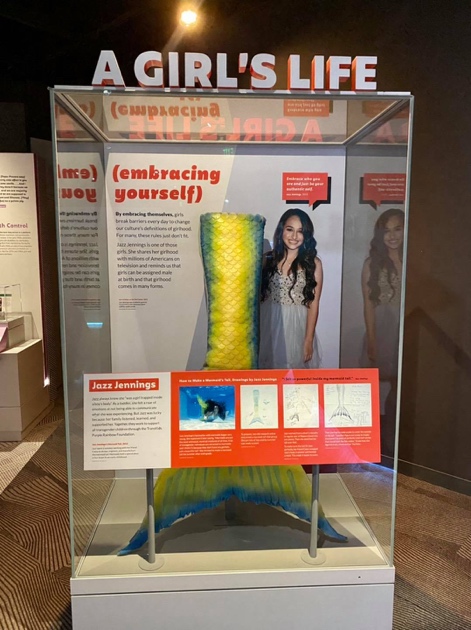
In October 2020, Smithsonian’s National Museum of American History revealed a new exhibit, “Girlhood… It’s Complicated!” just in time to celebrate International Day of the Girl. The exhibit features approximately 200 objects representing 200 years to explore “[W]hat it means to be a girl—and a woman—[which] has continuously been debated and negotiated, but has always been part of the national conversation.” To say ‘girlhood’ has been debated and negotiated feels like an understatement in today’s political climate, where virulent anti-queer and anti-trans conservatives have effectively waged war against trans childhoods through efforts to criminalize trans-affirming parents, caregivers, medical providers, educators, and school administrators that have proven largely successful. In this political climate, it is imperative that institutions with the power to change public narratives demonstrate support for transgender youth. The “Girlhood… It’s Complicated!” exhibit does just that, though it also could have done more.
Jazz Jennings is a notable inclusion as the only openly trans girl featured in the 5,000-square-foot exhibit, and as one of only five girls to be featured in the opening case, “A Girl’s Life”. The “A Girl’s Life” exhibit focuses on five themes: ‘Making an Impact,’ ‘Getting Organized,’ ‘Coming of Age,’ ‘Breaking Barriers,’ and lastly, ‘Embracing Yourself,’ which is the theme that frames Jazz’s story. At the age of six, Jazz and her parents were interviewed for a Barbara Walters’ special on transgender children that aired in 2007. The Jennings family has since sustained media attention through the publication of Jazz’s picture book and memoir, and a TLC reality show, I Am Jazz, that documents the experiences of the Jennings family as they collectively navigate the highs and lows of Jazz’s teenage years, where everything from dating and college applications to discrimination and gender-affirming medical care and surgeries is shared with the viewer. It is no question that Jazz is a girl who is making history. Plus, with all the abhorrent political campaigns targeting the rights, safety, care, and even the very existence of trans girls, it is a step in the right direction to include trans girls in an exhibit on girlhood at the Smithsonian American History Museum. Such a move by this huge cultural institution affirms that trans girls are valid and must be included in discussions on American girlhoods.
Such a monumental display of trans inclusion does not mean we should uncritically praise the museum for including Jazz in the exhibit, since the inclusion of only one trans girl can feel like tokenism (which seems to be a common issue in the exhibit as a whole, according to Tiffany R. Isselhardt). While Jazz’s advocacy efforts solidify her status as an influential girl making history, it would have been great to see more trans girlhoods (and especially more diverse trans girlhoods) included in the exhibit. Further, the inclusion of this trans girl in particular—one who is white, wealthy, currently attending an Ivy-league university, enthusiastically supported by her family, and has access to gender-affirming medical care and experiences other trans girls lack access to—suggests the exhibit is “not truly inclusive and representative of (trans) girls.” That said, although there is considerable room for improvement, I believe this is an important and positive step toward more inclusive representations of trans American girlhoods.
-E Feinman
Volunteer
GIrl Museum Inc.
